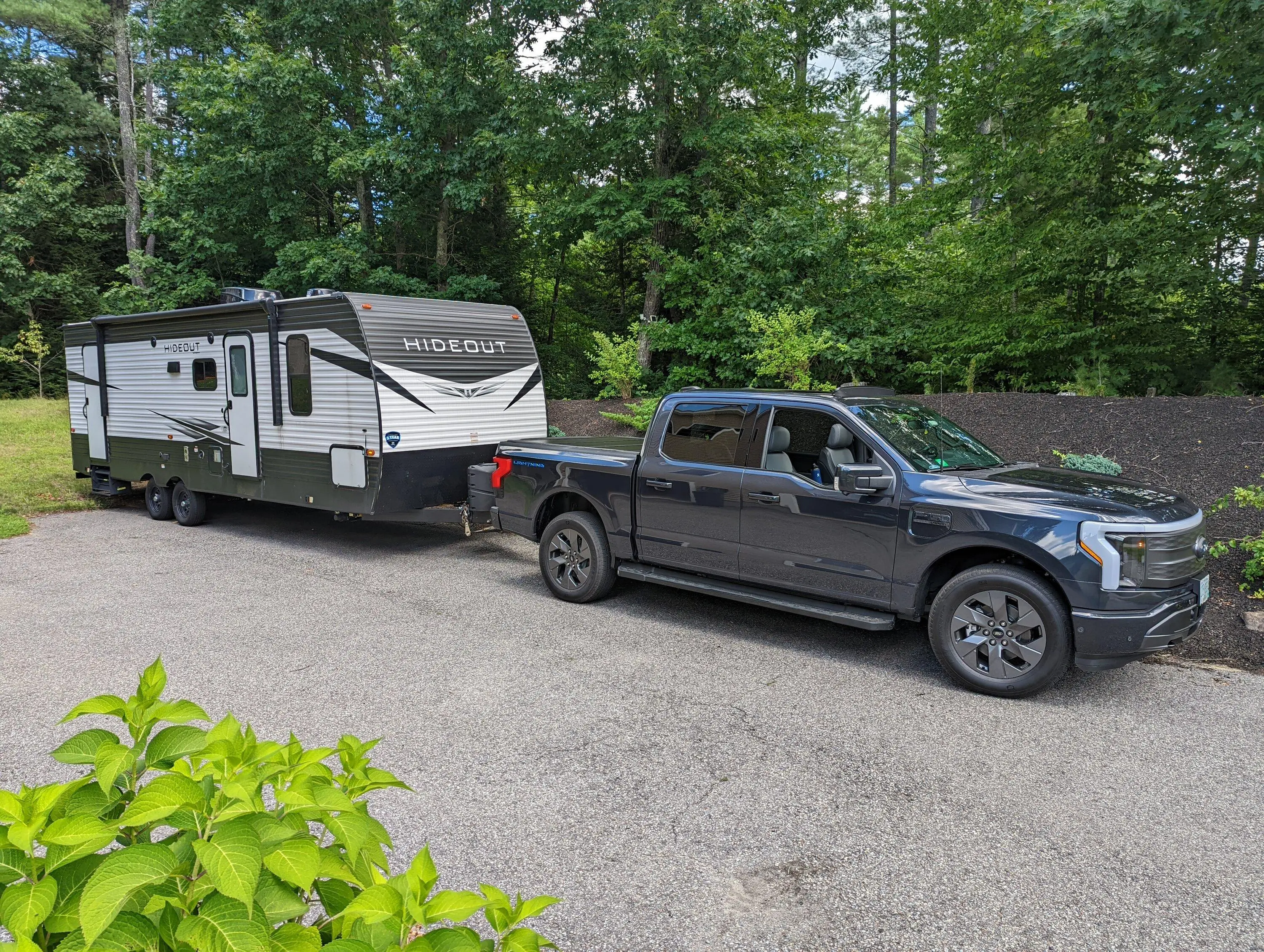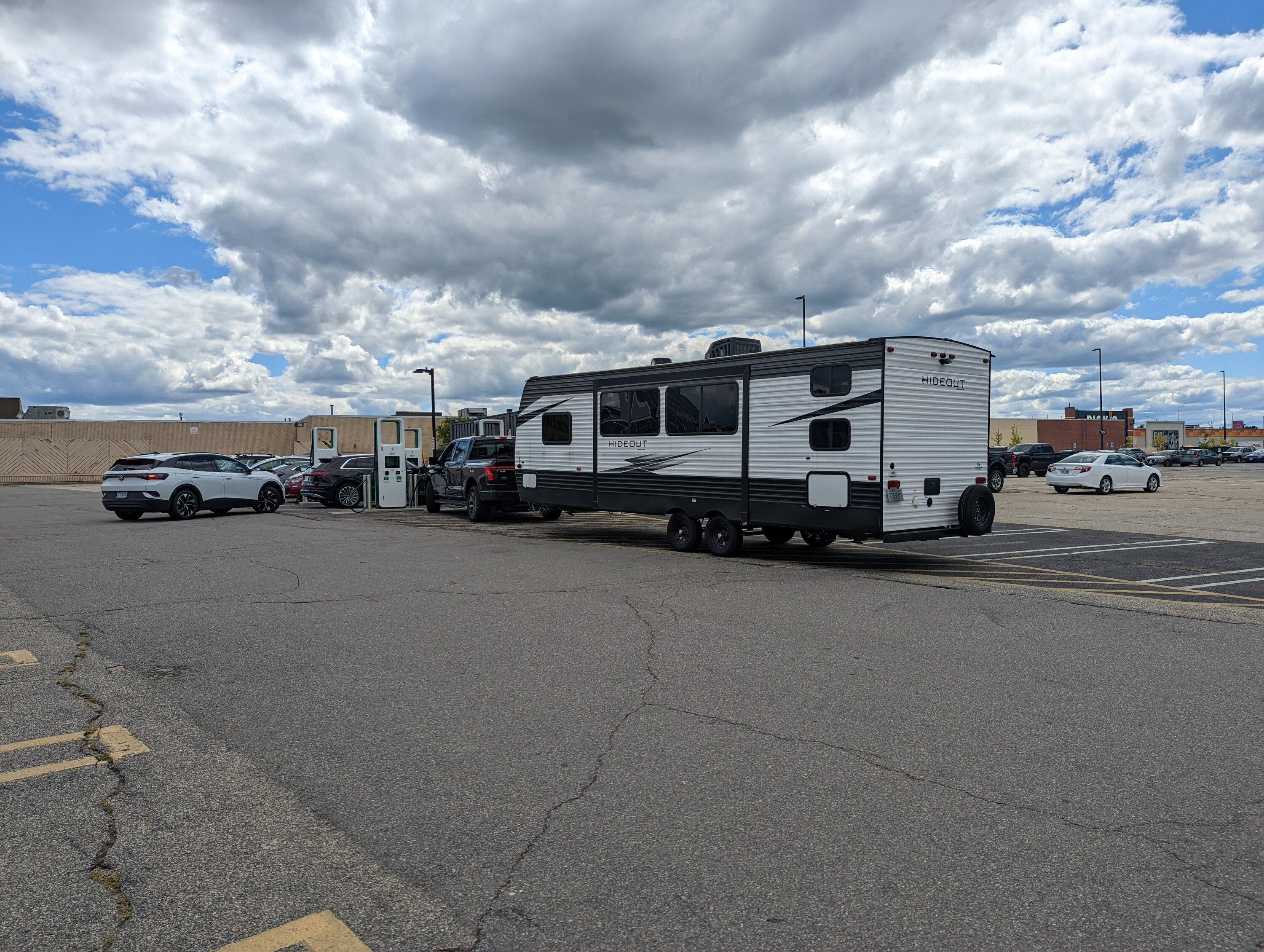rolker
Active member
- First Name
- Roland
- Joined
- May 26, 2022
- Threads
- 1
- Messages
- 32
- Reaction score
- 42
- Location
- New Hampshire
- Vehicles
- 2022 F150 Lightning Lariat ER
- Occupation
- Software Engineer
- Thread starter
- #1
After watching many towing videos featuring both the Lightning and the Rivian, I figured that the range I can expect towing my own camper would be half or less. Well, to know for sure, I hooked up my trailer for the first time and went for a test drive. It's 31' long and probably weighs about 7000 pounds.

Noticing on Plug Share that a Rivian had checked in at EA in Manchester, NH, while towing, I decided to also incorporate my first DC fast charging to the outing.
I left Epping, NH with 79% SOC, got on the hiway and set the cruise control to 65. When I got to the EA charger, the truck's "This Trip" display showed I had covered 26.3 miles at 0.8 mi/kWh and my remain range was only 55 miles! The charge display on the big screen showed my SOC to be 55%.
I was running ABRP to collect data using a BT dongle and those results show I drove 27 miles and my SOC went from 79 to 55.5. I calculate that to be 30.785 kWh used for the trip at a rate of 0.877 mi/kWh.

So, I decided to try charging to 90%, with the option of stopping early is some showed up and all the other stall were taken. I'm planning to drive up to Canada in a few weeks (without the trailer!) and there's a long stretch of I95 without a charger capable of 150kW between Portland, ME and the Canadian border. I wanted to know what's a feasible SOC I could reach beyond 80% in a resonable amount of time.
I didn't do a good job at keeping ABRP logging during the charging sessions so I didn't get good charging curve data. I was plugged intio a 150kW charger and it seemed to peek at around 135ish kW at first. The few data points I have are:
3 minutes in, 61% SOC, 134kW
38 minutes, 87% SOC, 20kW
53 minutes, 89% SOC, 7kw
When the power dropped lower than what I can provide at home using my L2 charger, I called it quits.
Summary from the charging station:
Total energy delivered 46.9779 kWh
End state of charge 89%
Charging time 54 min
Charging cost $0.00 + $0.32/min
Session fee $0.00
Charging $17.28
I have plug and charge setup and it worked fine. I did get a message in FordPass that my charging bundle reduced by 46.0 kWh.
On my return trip to Epping, I decided to try 60 mph instead of 65. The results were 0.9 mi/kWh over 25.8 miles.
Data collected with ABRP shows the SOC going from 90.0 to 69.5 so 26.855 kWh used at a rate of 0.968 mi/kWh.
Conclusions?
- Trip to Canada (New Brunswick) is not feasible (now) in a day if I bring the camper. Probably doable with lots of long charging stops at 50kW chargers if I also stop overnight around Bangor and charge at the campground using the 50 amp plug.
- If I want to achieve 1 mi/kWh, I'll probably have to drop my speed to 55 mph, or just stay off the highways.
- A 90% SOC is probably a bit too ambitious of a target to reach at DCFCs if I want to reach my destination in a reasonable amount of time. Maybe 85% and a slight drop in my cruise control setting would make more sense.

Noticing on Plug Share that a Rivian had checked in at EA in Manchester, NH, while towing, I decided to also incorporate my first DC fast charging to the outing.
I left Epping, NH with 79% SOC, got on the hiway and set the cruise control to 65. When I got to the EA charger, the truck's "This Trip" display showed I had covered 26.3 miles at 0.8 mi/kWh and my remain range was only 55 miles! The charge display on the big screen showed my SOC to be 55%.
I was running ABRP to collect data using a BT dongle and those results show I drove 27 miles and my SOC went from 79 to 55.5. I calculate that to be 30.785 kWh used for the trip at a rate of 0.877 mi/kWh.

So, I decided to try charging to 90%, with the option of stopping early is some showed up and all the other stall were taken. I'm planning to drive up to Canada in a few weeks (without the trailer!) and there's a long stretch of I95 without a charger capable of 150kW between Portland, ME and the Canadian border. I wanted to know what's a feasible SOC I could reach beyond 80% in a resonable amount of time.
I didn't do a good job at keeping ABRP logging during the charging sessions so I didn't get good charging curve data. I was plugged intio a 150kW charger and it seemed to peek at around 135ish kW at first. The few data points I have are:
3 minutes in, 61% SOC, 134kW
38 minutes, 87% SOC, 20kW
53 minutes, 89% SOC, 7kw
When the power dropped lower than what I can provide at home using my L2 charger, I called it quits.
Summary from the charging station:
Total energy delivered 46.9779 kWh
End state of charge 89%
Charging time 54 min
Charging cost $0.00 + $0.32/min
Session fee $0.00
Charging $17.28
I have plug and charge setup and it worked fine. I did get a message in FordPass that my charging bundle reduced by 46.0 kWh.
On my return trip to Epping, I decided to try 60 mph instead of 65. The results were 0.9 mi/kWh over 25.8 miles.
Data collected with ABRP shows the SOC going from 90.0 to 69.5 so 26.855 kWh used at a rate of 0.968 mi/kWh.
Conclusions?
- Trip to Canada (New Brunswick) is not feasible (now) in a day if I bring the camper. Probably doable with lots of long charging stops at 50kW chargers if I also stop overnight around Bangor and charge at the campground using the 50 amp plug.
- If I want to achieve 1 mi/kWh, I'll probably have to drop my speed to 55 mph, or just stay off the highways.
- A 90% SOC is probably a bit too ambitious of a target to reach at DCFCs if I want to reach my destination in a reasonable amount of time. Maybe 85% and a slight drop in my cruise control setting would make more sense.
Sponsored



